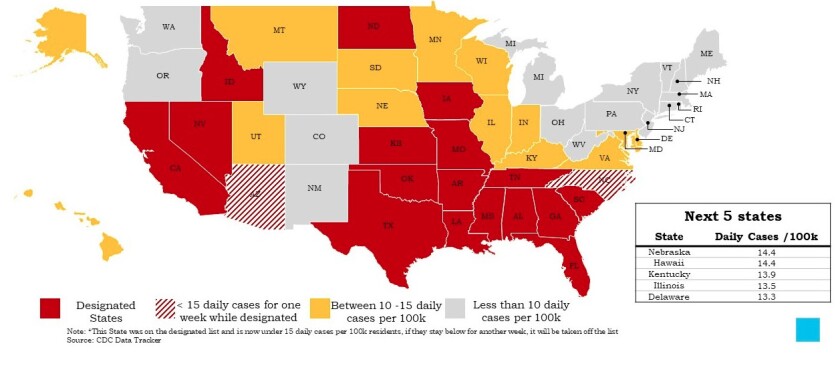Officials announced Tuesday that Wisconsin and Nebraska have been dropped from the city’s COVID-19 quarantine list, though travelers to Chicago from 19 other states and Puerto Rico must still isolate for 14 days.
That includes visitors from Iowa and Kansas, which were both added back to the list this week, Chicago Department of Public Health Commissioner Dr. Allison Arwady said during a City Hall news conference.
Workers deemed essential are exempt from the order, though Arwady noted they must “limit their activities to work-related activities [and] avoid public spaces as much as possible.”
Arizona and North Carolina also could be removed next week if the states can remain below the threshold of 15 daily cases per 100,000 residents for a second straight week, Arwady said. The list is updated every Tuesday, with changes taking effect the following Friday.
Wisconsin and Nebraska were added to the quarantine list last month, along with Missouri and North Dakota, two states still designated for their rates of infection.
Arwady announced that in recent weeks Chicago has recorded roughly 300 new cases each day, down from a peak of roughly 1,000 daily cases in early May.
But to “move forward thinking about reopening,” Arwady said that number would have to come down to about 200 daily cases. And if, instead, that number ticks up to 400 cases per day, the city may have to “think about pulling back even further.”
The community spread is now mostly in households and at small gatherings, instead of at workplaces and congregate settings, said Arwady. But officials haven’t seen “a lot” of transmission tied to large events, like protests and religious gatherings, she added.
Arwady said 18-to-29-year-old Chicagoans are now being infected at the highest rate, instead of the older, more vulnerable residents who were hit hardest earlier.
What’s more, Arwady said, the virus still “disproportionately” affects Latino Chicagoans. As a result, officials are focusing on areas with large Hispanic populations and high population density.
Meanwhile, the number of hospitalizations and deaths has stabilized. Over the past few weeks, Arwady said the city has seen roughly three daily COVID-19 deaths, down from about 50 at the virus’ peak.
Though testing has remained “consistently high,” with the city averaging about 7,500 daily tests, Arwady said the city’s test positivity rate still sits around 5%.
“We would like that below 5% ideally, but we’ve not seen it spike up like we’ve seen in other parts of the state and some other parts of the country,” said Arwady. “So we continue to be in a little bit of a holding pattern there.”
Asked whether Chicago could add counties in Illinois with spiking case numbers to the list, Arwady noted the state has already designated 14 “counties of concern” but said city officials would evaluate taking that step only if there were “major issues,” adding that “anywhere the outbreak is not in control in Illinois is of big concern for us.”






